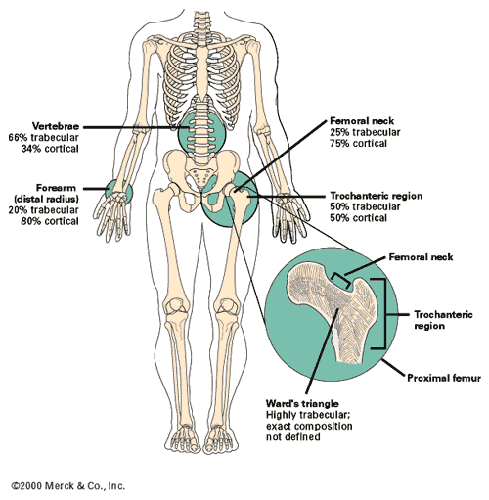Our bones are not at all like the bones you may have seen in labs, on a skeleton, or even after a non-vegetarian meal. Usually people see or notice only the “hard” parts of a bone. This is the mineralized bone, which is generally made up of calcium salts that are deposited between the collagen fibers of the bone. What is missing is the mesh of collagen, which is much more leather-like than hard. In living bone there is a significant portion of both collagen and calcium salts. The mineral salts help us tolerate compression of the bone while the collagen helps us resist tension that would bend or break the bone.
If the bone was made only of mineral salt and was subjected to extreme pressure, it would snap the way an old tree branch breaks: cleanly. However, healthy, especially young bone, with a high degree of collagen meshing, breaks more like a living branch of a tree. If you have ever tried to snap off a living branch you know that is just bends, crumpling one side while fraying the side away from the pressure. [1]
 Examined closely, the inside of our bones appears porous. This sponge-like scaffolding allows the bones to be light and yet incredibly strong. The spongy-looking part is called “trabecular” bone and it is more elastic than the harder outer skin of the bone, which is called “cortical” bone. Trabecular bone is more active, more subject to bone turnover, to remodeling. The ratio of trabecular to cortical bone varies throughout the body depending upon the need. For example, the bones of the rib are not weight bearing and so they have much higher trabecular content. Our leg bones have much more cortical bone. [See image to the right]
Examined closely, the inside of our bones appears porous. This sponge-like scaffolding allows the bones to be light and yet incredibly strong. The spongy-looking part is called “trabecular” bone and it is more elastic than the harder outer skin of the bone, which is called “cortical” bone. Trabecular bone is more active, more subject to bone turnover, to remodeling. The ratio of trabecular to cortical bone varies throughout the body depending upon the need. For example, the bones of the rib are not weight bearing and so they have much higher trabecular content. Our leg bones have much more cortical bone. [See image to the right]
Cartilage is similar in makeup to bone but has a different ratio of collagen to mineral salts and other components. The cartilage in our nose, for example, has much more hydration [2] than our bones. The cartilage in our ears is even more flexible thanks to the presence of more elastin fibers. In our intervertebral disks we have fibrocartilage with a higher proportion of collagen to chondroitin. This allows the cartilage in our spines to have greater weight-bearing support than we would find in the cartilage in our ears.
Cartilage supports tissues and provides a degree of structure and firmness. Bones do exactly the same thing, but to a different degree. Of significant interest to the student of yoga are the three kinds of the “other” connective tissues: tendons, ligaments, and the fasciae. Each of these has different degrees of flexibility, caused by their different makeup. We have already looked at fasciae, so now let’s look at tendons and ligaments.
(Next: Tendons and Ligaments )
